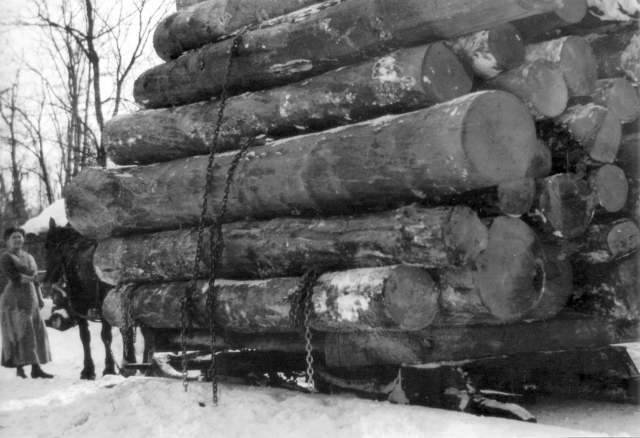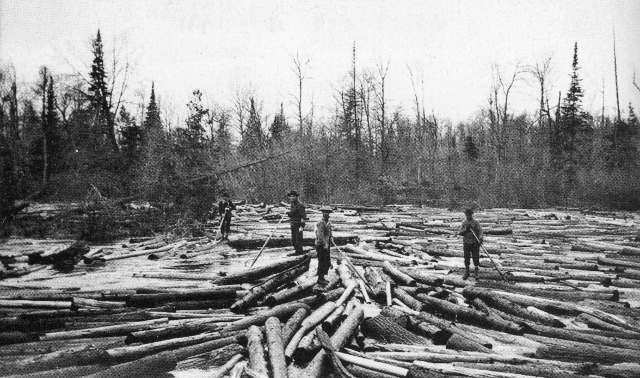
Log Drive on the Manistique River (1890’s Photo)
In July of 1929, the largest remaining stand of Michigan’s virgin white pine forest floated down the Manistique River toward the Stack Lumber Company sawmill in the town of Manistique. The giant pine had been scattered over 3,200 acres of swampy forest at the head of the Driggs River, a tributary of the Manistique River—in an area previously considered too inaccessible for logging operations. The 1929 drive included 600,000 feet of Norway and white pine, 1,000,000 feet of hemlock and 800,000 feet of hardwood (birch, oak, maple, elm and basswood). The log drive marked the end of big pine lumbering in Michigan which began along the Saginaw River valley in 1833. Once thought inexhaustible, the great pine forests were all logged off in Lower Michigan by 1895 and in Upper Michigan by 1905. A total of 190 billion feet of lumber had succumbed to the woodman’s axe.
The 1929 drive paled in comparison to those of the 1880s and 1890s, when 100 million to 125 million feet of virgin pine logs floated down the Manistique River each year. It is estimated that over 3 billion feet of pine lumber was driven down the Manistique from the time that lumbering operations began in the area prior to the Civil War.
Pioneer lumberman, Frank N. Cookson, was in charge of this final drive of the white pine era. Harvey Saunders, a nephew of Cookson and a Maine logging veteran, was the foreman. The giant pine logs for the 1929 drive were harvested in the fall of 1928 in swampy ground at the head of the Driggs River in Schoolcraft County. These marvelous examples of white and Norway pine measured from 24 to 30 inches at the stump and stood between 90 and 110 feet high. During the winter, the big timber was hauled to the banks of the river by drays and teams of horses, where it was piled on the banking grounds to await the spring driving season.

Logging operations in Schoolcraft County (1890’s Photo)
Cookson employed about 100 men in his lumbering operations in 1929, but only men with very specialized skills were river drivers. Dressed in warm woolen clothing and wearing caulked boots, the river drivers rode the logs downstream. They carried peaveys (long wooden poles with a metal hook on the end) to manipulate the logs and avoid pile-ups. The most dangerous aspect of a river driver’s occupation was dislodging big jams. If a jam did occur, it was the river driver’s job to find the log that was causing the jam and free it from any snag or debris. Once the key log was located and dislodged, the river men scampered to the safety of the shore. During the heyday of big pine lumbering, many river drivers lost their lives when they were swept away by the raging cascade of wood and water. For large or intractable jams, dynamite was used to clear the obstruction and get the timber moving again.
The historic drive began in April of 1929. Driving giant pine logs on the Driggs River was dependent on the use of dams to regulate the water level so the logs could be easily floated downstream. The pine and hemlock for the 1929 drive were floated a distance of 30 miles on the Driggs to where it joins the larger Manistique River. Here the logs were held in a boom until the spring flood on the Manistique had receded and the water no longer overflowed its banks.
When the flood waters subsided, the hemlock logs were sent down the river first. Hemlock logs float well but are not buoyant enough to support hardwood, so they are unsuitable for rafts. During the winter, hardwood timber had been piled along the shore of the river to be rafted with the pine logs. Otherwise, the maple, oak and other hardwood species would sink to the bottom. Saunders and his crew were able to construct approximately seventy-five rafts each day. After each raft was finished it would be sent on through the boom to the Stack Lumber Company mill in Manistique. The whole rafting enterprise (lasting three weeks) was finished in mid-July, 1929. Once all the pine and hardwood rafts had reached Manistique, the “short-stuff” including cedar posts and pulpwood was sent down the river. By August of 1929, the legendary era of virgin pine lumbering had come to a close.

River Hogs on the Manistique River
